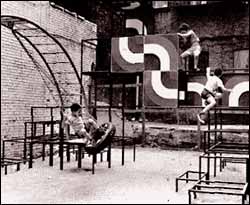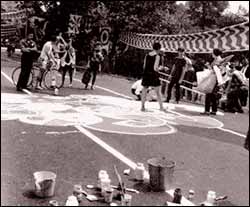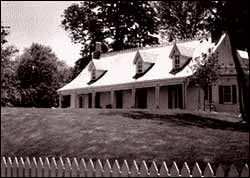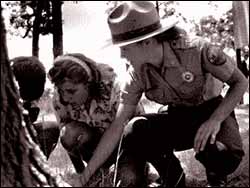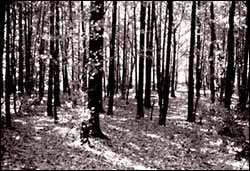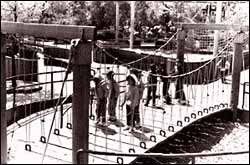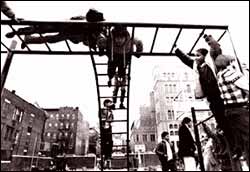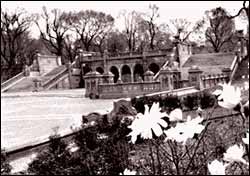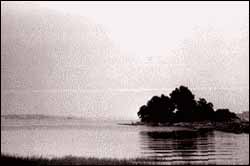Rediscovery and Restoration (1965–1987)
1965
John V. Lindsay, as a mayoral candidate, published his "White Paper" on parks and recreation in 1965. The document emphasized growing concerns for more community involvement in Parks Department policy decisions. It also suggested innovations, such as tiny "vestpocket" and "adventure" playgrounds, which were later implemented during the Lindsay administration (1966-1974).
The Landmarks Preservation Commission was established in 1965. In the same year Central Park was declared a National Historic Landmark by the U.S. Department of the Interior.
The New York Philharmonic Orchestra performed in its first free Central Park concert in 1965. Two years later the Metropolitan Opera joined the park program. These groups revived a tradition of free summer performances in the parks which began in 1859 with musical programs performed by a small orchestra on the Central Park Mall.
1966
The Office of Cultural Affairs was transferred from the Mayor's office to the Parks Department. At the same time, newly appointed Park Commissioner, Thomas P.F. Hoving, encouraged the wider use of parks as settings for major cultural, artistic, and avant garde events. Cars were banned in Central Park on Sundays, and a wide variety of activities and "happenings" not traditionally associated with parks were sponsored by the Parks Department.
1967
Under Park Commissioner August Heckscher, 10 vest pocket parks were completed in 1967 in vacant city lots of one-quarter acre or less. New play equipment for playgrounds inspired by European "adventure" playgrounds, was designed by Parks Department design consultants. Cargo nets, cat walks and free-form climbing equipment replaced the swings, slides and seesaws which had characterized municipal playgrounds since 1903.
Barbara Streisand drew a large crowd to the first major free concert in Central Park's Sheep Meadow. The Thomas Pell Wildlife Refuge in Pelham Bay Park, the second such refuge in the city, was created in 1967.
1968 The Parks, Recreation and Cultural Affairs Administration (PRCA) was created when Mayor Lindsay consolidated the city's more than 50 agencies into a dozen "superagencies." In addition to the regular responsibilities of the parks and recreation departments, the PRCA had charge of funneling millions of dollars to libraries, botanical gardens and performing arts groups.
The parks division itself, though, suffered annual budget cuts and staff reductions throughout this period. By the early 1970s attrition had caused a serious staff shortage.
1970
The first annual New York City Marathon was held in Central Park in 1970. Its course consisted of successive loops around the Central Park Drive. In 1976 the Marathon route was changed to encompass all five boroughs, but the final miles are still run in Central Park.
1973
An amendment was passed to the Landmarks Preservation Law of 1965 allowing for the designation of landscapes as Scenic Landmarks, making parks eligible for city landmark status. Since that time the Landmarks Preservation Commission has designated Central Park, Grand Army Plaza (Manhattan), Prospect Park, Riverside Park, Fort Tryon Park, Bryant Park, Verdi Square, and Eastern and Ocean Parkways as New York City Scenic Landmarks. Sixteen other parks lie within designated Historic Districts.
1974
The Gateway National Recreation Area, a national park, was established. Over 13,000 acres of city parkland in Brooklyn, Queens and Staten Island were transferred to the National Park Service in this major reassignment of jurisdiction over the city's parks, beaches, and wetlands.
1975
The city fiscal crisis seriously aggravated the problems of an already strained parks system. In the early 1970s, the Parks Department had begun to plan capital restoration projects for the parks, such as the 1973 masterplan for Central Park. Such initiatives were delayed by the fiscal crisis. Already minimal staffing levels were further cut, particularly for recreation programs.
1976
Under Mayor Abraham D. Beame, two autonomous agencies, the Department of Parks & Recreation and the Department of Cultural Affairs were established in 1976 to replace the Parks, Recreation & Cultural Affairs Administration.
1978
Mayor Edward I. Koch appointed Parks Commissioner Gordon J. Davis, who initiated "load-shedding" management policies to improve maintenance for parks. Many parks facilities, such as ice skating rinks and golf courses, were turned over to private concessionaires who operate and maintain them by permit. Arrangements were made to transfer the operations of the three city zoos to the New York Zoological Society. Roving park maintenance crews were started to make up for the absence of fixed-post workers in neighborhood playgrounds. The City Council also transferred maintenance responsibilities for parkways to the Bureau of Highways for roadbed maintenance and to the Department of Sanitation for litter and snow removal.
The United States Tennis Association moved to the Louis Armstrong Stadium in Flushing Meadows-Corona Park in 1978. The stadium had been the Singer Bowl, built for the 1939 World's Fair. The annual united States Open Tennis Championships are held in the stadium every year.
1979
The Urban Park Ranger force was established. The Rangers patrol parks and provide nature interpretation to park visitors in all five boroughs. They sponsor special programs such as Junior Rangers, nature trail design and maintenance projects, and environmental fairs.
1981
As the city reentered the municipal bond market in 1981, Mayor Koch issued his first ten-year capital plan. The plan proposed a $750 million commitment to rebuild the city's parks. For the first time in years, the Parks Department was also building up its permanent work force, which had fallen to under 2,500 workers in 1980 from over 5,200 in 1965.
Another uniformed force, the Park Enforcement Patrol (PEP), joined the Rangers. PEP Officers are responsible for promoting proper use and enjoyment of parks by enforcing park rules and regulations as well as health, traffic and sanitation codes.
1982
The Department of Parks & Recreation began to decentralize its administration. Borough commissioners were appointed by the Park Commissioner to manage agency operations locally, in cooperation with central administration in the Arsenal. Since 1984, all five boroughs have been administrated by borough park commissioners.
1983
Newly appointed Parks & Recreation Commissioner Henry J. Stern established the "Greening Policy" for the Parks Department. Green spaces and tree were given new consideration and protection in an effort to revitalize the city's only living infrastructure: parks.
1984
The Natural Resources Group (NRG) was established to develop management strategies aimed at preserving and protecting New York City's 7,000 acres of undeveloped natural forests and wetlands. NRG has since distinguished itself as an international leader in restoration ecology, research and parks management.
The Neighborhood Park Restoration (NPR) program was initiated. NPR is the largest in-house restoration of local parks and playgrounds undertaken by the Parks Department since the 1930s. This intensive maintenance program employs crews of Parks Department craftsmen to rehabilitate neighborhood playgrounds before costly capital reconstruction becomes necessary. NPR is designed to revive parks and playgrounds and protect the capital investment made in them by deploying fixed post workers—parkies—at many restored sites.
The country's first completely accessible playground, the Playground for All Children, opened in Flushing Meadows-Corona Park in 1984. The play equipment and facilities at the playground are designed for use by disabled and able-bodied children.
1986
For the first time park maintenance replaced police patrols as the number one priority of the city's 59 Community Boards. Out of 70 services provided by 22 city agencies, the maintenance and improvement of the city's parks and playgrounds were given first priority--even over uniformed services such as fire and police.
The city was host to the Centennial Celebration for the Statue of Liberty, one of the largest national celebrations of the century, during the Fourth of July weekend. Over six million visitors from all over the country and the world converged on New York, especially Battery Park, to wish the Lady of the Harbor a happy birthday. The Liberty Weekend concert on the Great Lawn in Central Park was an especially popular part of the celebration.
1987
Bethesda Terrace, the architectural heart of Central Park, reopened after a $4 million restoration paid for by the city's capital budget. The Terrace's reopening marked an important milestone in the preservation of historic parks in New York, and is symbolic of the restoration of parks and playgrounds of all eras throughout the city. The resurgence of public concern for open, green spaces has lead to a new awareness of our park legacy, and has forged a renewed commitment to preserve it for future generations.
Adopt-A-Monument—a joint program of Parks & Recreation, the Municipal Art Society and the New York City Art Commission—was formed to solicit private contributions for conservation and maintenance of select monuments within Parks' vast collection of sculptures, fountains, and memorials. As of 1997, more than $1 million has been raised, and 36 monuments have been adopted and rescued from the ill effects of pollution, vandalism and age.
The Prospect Park Alliance was launched in 1987 as a non-profit support organization modelled after the Central Park Conservancy. The Alliance raises funds, underwrites visitor services and oversees this Brooklyn park's twenty year comprehensive restoration program.
CREDITS:
Writer: Ethan Carr
Researcher: Catherine A. Christen
